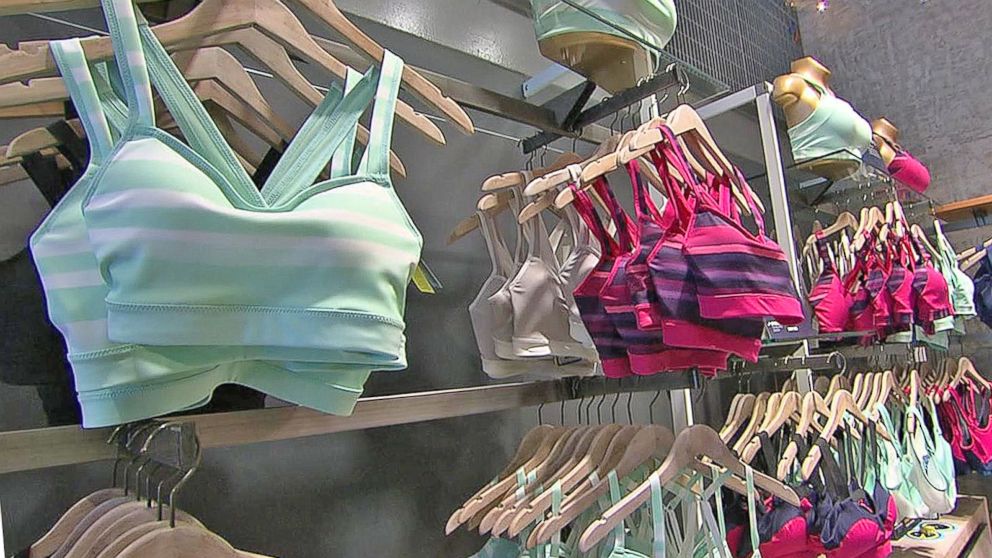Sports Bras: Does New Tech Mean More Comfort?
— -- Sports bras are used by nearly all women when it comes to working out, yet a quarter of all women say their bras hurt them when they exercise or they experience pain from activity, according to Brooks, the makers of sneakers, running garb and bras. But it doesn’t have to be that way.
Stacy Steffen is a biomechanist at Brooks. She took me into the lab where they bring motion-capture technology to the evaluation of each new bra they design. “We’re looking at the vertical motion, side-to-side and in-and-out motion, and we look at that collectively and in 3D to get an ideal range," she said.
What are also called "jog bras" used to be all about compression -- suppressing movement by uniformly pushing breasts down close to the chest. But that smushing comes with issues. Namely, you look like you have one long “uniboob” and all that compression isn’t comfortable. Now, bra makers have brought sophisticated engineering and testing methods (like motion-capture analysis) to the creation of bras. These methods isolate the specific areas of movement without compressing everything.
Back in the lab, Steffen collects data. She used markers on test-runner Jordan Flickinger’s shoulders and hips as a baseline. She also put markers on Jordan’s bra to see how different the movement is. That excess breast movement is then quantified.
“You'll see different up-and-down [movement], side-to-side, in-and-out, and that will change in the 3D pattern because the breasts move in a figure eight and so the motion isn't just up and down," Steffen said. "We want to make sure we stop it happening all around.”
Armed with that info, designers place stronger compression in areas of movement, but leave other areas alone without compression. The end result is jog bras that can now offer shape. To use the old bra marketing phrase, they can lift and separate. Goodbye, uniboob!
To show the difference an engineered bra can make, we started Flickinger in a strappy bra I purchased -- not a Brooks bra. Jordan ran and quickly commented on the bra. “It feels a little off,” she said. She also reported that there was a fair amount of bounce and the straps were digging into her shoulders.
When Jordan changed into an engineered bra from Brooks, the movement went way down. Crunching the motion-capture data, Steffen said this bra reduced vertical motion by 66 percent, horizontal movement by 47 percent and in-out movement by 11 percent.
That reduction in movement can make a huge difference. One of Brooks' other testers, Robyn Winters, agreed.
Winters is an avid runner and wears a bra size of 34F. When I asked Winters what it feels like to run in a bra that doesn’t offer the right support, she was quick to answer. ”It hurts like you can almost like feel a muscle tear almost just from the movement because you're going side to side and up and down so ... it's not good," Winters responded.
As more of us get active, bra companies are taking note. I found a zip-up sports bra promising extra support from Victoria's Secret_" target="_blank">Victoria's Secret. Nike has running bras up to 38E and Title Nine, a catalog founded on athletic bras, has a slew of bras rated as triple barbells.
As for that old bra (you know the one), I took mine up to Brooks and showed it to Rebecca duRivage-Jacobs, bra product line manager at Brooks. I pulled out the ratty bra and confessed: “I have to admit something, this bra that I brought with me is quiet possibly 15 years old. I still wear it.”
DuRivage-Jacobs is not shocked. “I appreciate you being so comfortable sharing this with me," she said. "We get this a lot.”
DuRivage-Jacobs said we don’t think about replacing our bras regularly, but it’s important. “The hard work that a sports bra is doing during performance, in the wash, on the run, they're durable pieces of equipment, but you take them through the paces.” She recommends replacing bras at least once a year. “Bras should not celebrate a birthday.," she said.
The other benefit to this regular replacement schedule is the process of going in to be measured.
DuRivage-Jacobs said the sports bra you purchased a year ago may not be fitting you the same way it once was. Our bodies change more than we think and a ridiculously large part of the population are in bras that aren’t the correct size, she added.
Stores like the Brooks flagship store in Seattle, Title Nine and Victoria's Secret will measure you and tell you what size you should be wearing.
Two last factoids about bras: the trend toward strappy bras could make you think that they offer less support.
However, companies like Lululemon, Athleta and Brooks are trying to combine fashion and engineered support. Steffen says 80 percent of the bra's support actually comes from the band around your ribs. So as long as you run around in the dressing room testing to make sure you feel supported and that the straps don’t dig into your shoulders, some people can get enough support from the strappy options.
In addition, teen girls need lots of guidance around jog bras. New research from the Journal of Adolescent Health shows many athletic girls drop out of sports because they are uncomfortable with their developing bodies. Proper support and guidance is crucial.




